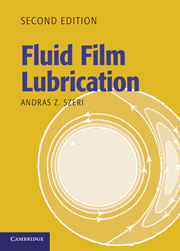Book contents
- Frontmatter
- Contents
- Preface to the Second Edition
- Preface to the First Edition
- Chapter 1 Introduction
- CHAPTER 2 Basic Equations
- CHAPTER 3 Thick-Film Lubrication
- CHAPTER 4 Dynamic Properties of Lubricant Films
- CHAPTER 5 Effects of Fluid Inertia
- CHAPTER 6 Flow Stability and Transition
- CHAPTER 7 Turbulence
- CHAPTER 8 Elastohydrodynamic Lubrication
- CHAPTER 9 Thermal Effects
- CHAPTER 10 Lubrication with Non-Newtonian Fluids
- CHAPTER 11 Gas Lubrication
- CHAPTER 12 Molecularly Thin Films
- CHAPTER 13 Biotribology
- Index
Preface to the First Edition
Published online by Cambridge University Press: 05 June 2012
- Frontmatter
- Contents
- Preface to the Second Edition
- Preface to the First Edition
- Chapter 1 Introduction
- CHAPTER 2 Basic Equations
- CHAPTER 3 Thick-Film Lubrication
- CHAPTER 4 Dynamic Properties of Lubricant Films
- CHAPTER 5 Effects of Fluid Inertia
- CHAPTER 6 Flow Stability and Transition
- CHAPTER 7 Turbulence
- CHAPTER 8 Elastohydrodynamic Lubrication
- CHAPTER 9 Thermal Effects
- CHAPTER 10 Lubrication with Non-Newtonian Fluids
- CHAPTER 11 Gas Lubrication
- CHAPTER 12 Molecularly Thin Films
- CHAPTER 13 Biotribology
- Index
Summary
Fluid film bearings are machine elements which should be studied within the broader context of tribology, “the science and technology of interactive surfaces in relative motion and of the practices related thereto.” The three subfields of tribology -- friction, lubrication, and wear -- are strongly interrelated. Fluid film bearings provide but one aspect of lubrication. If a bearing is not well designed, or is operated under other than the design conditions, other modes of lubrication, such as boundary lubrication, might result, and frictional hearting and wear would also have to be considered.
Chapter 1 defines fluid film bearings within the context of the general field of tribology, and is intended as an introduction; numerous references are included, however, should a more detailed background be required. Chapters 2, 3, and 4 outline classical lubrication theory, which is based on isothermal, laminar operation between rigid bearing surfaces. These chapters can be used for an advanced undergraduate or first-year graduate course. They should, however, be augmented with selections from Chapter 8, to introduce the students to the all-important rolling bearings, and from Chapter 9, to make the student realize that no bearing operation is truly isothermal. Otherwise, the book will be useful to the industrial practitioner and the researcher alike. Sections in small print may be omitted on first reading -- they are intended for further amplification of topics. In writing this book, my intent was to put essential information into a rational framework for easier understanding. So the objective was to teach, rather than to compile all available information into a handbook. I have also included thought-provoking topics; for example, lubrication with emulsions, the treatment of which has not yet reached maturity. I expect significant advances in this area as it impacts on the environment.
- Type
- Chapter
- Information
- Fluid Film Lubrication , pp. xv - xviPublisher: Cambridge University PressPrint publication year: 2010



